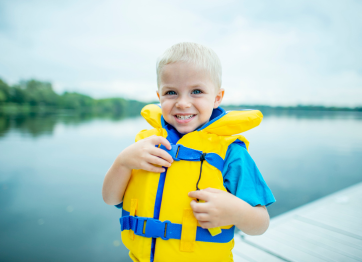It’s the first day of summer and we are in the midst of a heatwave–swim season is here! From oceans to lakes to swimming pools, water is everywhere: 71% of the Earth’s surface is covered in it. Moreover, while water can be an irresistible place for kids to explore, cool off, play and enjoy splashy fun, it can be risky for those who haven’t yet developed their water smarts. Consider that drowning is the leading cause of injury death for children ages 1-14. In fact, three children die each day from drowning.
“As families prepare for a summer of fun, this is a good time to remind families about the importance of water safety measures which can save lives and prevent drownings and serious water-related injuries among children,” says Dr. Lisa Sotir, Chair of Emergency Medicine. “Children can drown quickly, within minutes, and silently, without any splashing, crying or calling for help. It is very important to keep young children within arm’s length, and never leave children unattended when in or near water.”
Drowning of children is very preventable. To keep your kids safe around water, Dr. Sotir advises to follow these 10 safety tips:
- Kids can drown in a few inches of water. Bath tubs, buckets and even toilets pose a drowning risk. Keep toilet lids closed. Store empty buckets and tubs upside-down so they don’t collect water.
- Drowning can be very quiet. Don’t assume you’ll hear if a child is in distress. Children can drown in a few minutes without splashing or noise.
- Maintain constant supervision of children around water. Have a designated adult watch children at all times. It’s ultimately the parent or caregiver’s responsibility — not the lifeguard’s — to supervise a swimming child. Avoid distractions to supervision, such as reading, looking at your phone/tablet, preparing food or drinking alcohol.
- Insist that your child wear a Coast Guard-approved life jacket or personal flotation device (PFD) around natural bodies of water. Air-filled water aids (such as water wings, pool floats or noodles) do not count as a PFD and won’t protect against drowning. Verify that the proper equipment is being used or bring your own.
- Learn CPR. If a child takes in water, minutes count and resuscitation should be started immediately.
- Clear the pool and deck areas of toys so kids aren’t tempted to go near the pool area to play.
- Enroll your child in swim lessons, and make sure they learn the five water survival skills:
- Step or jump into water over your head and return to the surface
- Float or tread water for one minute
- Turn around in a full circle and find an exit from the water
- Swim 25 yards to the exit
- Exit from the water. If in a pool, be able to exit without using the ladder.
- Don’t assume a child who has had swim lessons is immune to drowning. Almost half of kids aged 10-17 that drowned in a pool reportedly knew how to swim.
- Home pools should have at least a 4-foot-high enclosure fence and a self-latching gate. The gate latch should be high enough that children cannot reach it. Isolation fencing (i.e. fencing that separates and encloses the pool away from the rest of the yard) is more effective than perimeter fencing (where the pool and yard are enclosed together). For above ground pools, remove access ladders when not in use.
- Pool covers and door alarms can add extra protection, but they shouldn’t be used in place of a fence.
Go to redcross.org/watersafety for swim program information and a variety of resources.
If you find yourself or your child in a water emergency, call 911 or head to the nearest Emergency Department. MetroWest Medical Center’s Emergency Department is conveniently located in downtown Framingham at 115 Lincoln Street, Framingham, MA.

